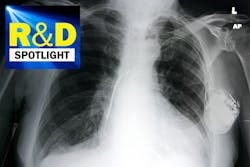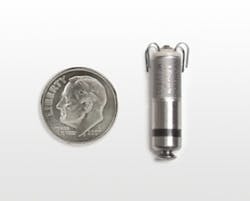R&D Spotlight: Never Skip a Beat: Pacemaker Trials Strive for Leadless Devices
Earlier this year, researchers called attention to the idea that high power charging stations for electric cars have the potential to create strong electromagnetic fields and cause electromagnetic interference in pacemakers and defibrillators.
Consternation about the risks were waylaid when the study, published in EP Europace—a journal of the European Society of Cardiology (ESC)—made clear that high power electric vehicle chargers are safe for patients with pacemakers and defibrillators.
Participants in the study had their pacemakers programmed to detect electromagnetic interference. They would plug in and charge a car with the charging cable placed directly over their cardiac device to maximize the likelihood of electromagnetic interference. Of the 561 charges performed, there were no adverse events caused by electromagnetic interference, stated the authors.
The ESC study is just one in a labyrinth of R&D that demonstrates the due diligence that goes into designing one of the most influential inventions in cardiac care: the pacemaker.
The lifesaving, battery-operated device is used to regulate the heartbeats of people with chronic heart disease, such as atrial fibrillation and other forms of arrhythmia.
Current Scope of Pacemaker Market
As of this year, the number of implanted pacemakers will rise to 1.43 million units, according to Statista. Behind the greater need for these life-saving cardiac pacing devices, is the rising burden of cardiovascular diseases. The market is further bolstered by the increasing cost of cardiac disease management, favorable government policies and the launch of new technology.
By one estimate, the global pacemaker market is expected to reach $10.9 billion in 2027, from $5.4 billion in 2018. Analysts note that large players—including Medico S.p.A., Vitatron, Abbott, Medtronic, OSCOR, LivaNova Plc, Abiomed, Boston Scientific, Biotronik, Zimmer Biomet and Lepu Medical—have been observed to invest substantially in the development of new products.
While access to pacemakers may vary across regions, affordability remains a global concern. The United States, Germany and Japan hold the largest regional share of the global medical device industry sales.
The imperative to improve patient results for a range of pacemaker implantations with minimally invasive techniques is driving the growth of the pacemaker market. And as our two spotlight examples below demonstrate, ongoing collaboration between engineers, the physicians and patients are critical in supporting technology that improve both safety and efficacy.
Leadless Pacemakers
Writing in the The New England Journal of Medicine, researchers from Amsterdam UMC explained how they are helping to revolutionize a wireless pacemaker. Traditional pacemakers consist of a subcutaneous box under the collarbone with a wire connected to the heart by a vein. The cables tend to be fragile and may detach from the heart, or become infected, noted the authors.
A new vitamin-sized implantable device improves upon a version Amsterdam UMC invented 10 years ago. The clinical trial shows that the upgraded system, consisting of two pacemakers, can be placed in both the atrium and the ventricle of the heart—a feat that wasn’t possible before. Until now, a wireless pacemaker could only be placed in one cavity of the heart, the ventricle, stated the researchers.
Once placed in the atrium and the ventricle, the two components making up the device known as the Dual Leadless Mini Pacemaker communicate with each other via electrical pulses.
The pacemakers were implanted in 300 people who were followed for a minimum of three months. The results of this study showed that the treatment is safe and that the system works well. The innovation will enable a larger group of patients to be fitted with a wireless pacemaker, noted the researchers.
The Dual Leadless Mini Pacemaker was developed together with Abbott Laboratories. Approval is currently being sought for the CE Mark for use in the EU, which is expected at the beginning of 2024. In the U.S., FDA approval is expected in the third quarter of 2023.
Design a Smaller Catheter for Children
Wireless or leadless pacemakers may be a safe and effective short-term option for children with slow heartbeats, too, according to a study published in Circulation: Arrhythmia and Electrophysiology, a peer-reviewed journal of the American Heart Association.
In traditional pacemakers, leads connect the pacemaker to the heart in order to deliver electrical signals and keep the heart beating normally. This form factor may not be ideal for active children, who are at a higher risk for wire fractures and pacemaker complications. The wires in typical pacemakers may break or malfunction, noted the researchers.
In this randomized controlled clinical trial, researchers provide the first data on leadless pacemakers in a pediatric population in a real-world setting. The self-contained miniature device—the size of a AAA battery—is placed directly inside the patient’s heart. It does not require tiny leads to help regulate the heartbeat.
Researchers evaluated data in the registry for one brand of leadless pacemakers to analyze how well the leadless pacemaker performed in 63 children, ages 4 to 21 years (average age 15). For 77% of these children, this was their first pacemaker.
Despite promising outcomes, the leadless pacemaker is far from being a universal solution. The device can be safely implanted in select pediatric patients that need pacing. This limitation exists because a very large catheter designed for adults is used to place the leadless pacemaker and may increase the risk of major complications, the researchers explained.
“Since these are big catheters, selection of patients by size is very important,” said lead study author Maully J. Shah, M.B.B.S., director of cardiac electrophysiology in the Cardiac Center at Children’s Hospital of Philadelphia and a professor of pediatrics at the Perelman School of Medicine at the University of Pennsylvania, both in Philadelphia.
“Two out of the three complications occurred in patients weighing less than 60 pounds,” Shah said. “The femoral vein in the groin is the conventional route to place the leadless pacemaker. For some patients, especially the younger and smaller children, the jugular vein (in the neck) was a better option because it provides a more direct route to implant the tiny pacemaker in a smaller heart.”
The drawback limits the wider population from benefiting from this device and, in children, signals a lack of reliable future extractability of the pacemaker.
“Techniques and tools to place the device must be designed for smaller patients, specifically children, and there needs to be a mechanism to remove and replace this pacemaker without surgery when the battery runs out since pediatric patients will likely require pacing for the rest of their lives, which is several decades after implantation,” Shah said in a press note.
In addition, major limitations of this study are the small study size and short-term follow up.
Pacemakers Make History
The viability of an implantable pacemaker comes with an intriguing history. The inventor of the original device, Wilson Greatbatch, was an electrical engineer teaching at the University of Buffalo; he patented the first implantable pacemaker in 1959. At first Greatbatch was challenged to find a surgeon to back the invention. Success followed in 1960, when Greatbatch and his two collaborators—Dr. William Chardack, chief of surgery at Buffalo’s Veteran Hospital, and a colleague, Dr. Andrew Gage—performed a procedure on a 77-year-old man with a complete heart blockage. The patient reportedly survived “uneventfully for two years” before dying of natural causes.
By 1961, Greatbatch’s pacemaker team reported 15 patients who had pacemaker implants.
Greatbatch was a serial inventor who drew inspiration from interdisciplinary studies in medical electronics, agricultural genetics, the electrochemistry of pacemaker batteries and the electrochemical polarization of physiological electrodes. The intrepid engineer went on to invent the long-life corrosion-free lithium-iodine battery to power the pacemaker. With 300 patents under the belt, it should be no surprise he was inducted into the National Inventors Hall of Fame in 1980.
About the Author

Rehana Begg
Editor-in-Chief, Machine Design
As Machine Design’s content lead, Rehana Begg is tasked with elevating the voice of the design and multi-disciplinary engineer in the face of digital transformation and engineering innovation. Begg has more than 24 years of editorial experience and has spent the past decade in the trenches of industrial manufacturing, focusing on new technologies, manufacturing innovation and business. Her B2B career has taken her from corporate boardrooms to plant floors and underground mining stopes, covering everything from automation & IIoT, robotics, mechanical design and additive manufacturing to plant operations, maintenance, reliability and continuous improvement. Begg holds an MBA, a Master of Journalism degree, and a BA (Hons.) in Political Science. She is committed to lifelong learning and feeds her passion for innovation in publishing, transparent science and clear communication by attending relevant conferences and seminars/workshops.
Follow Rehana Begg via the following social media handles:
X: @rehanabegg
LinkedIn: @rehanabegg and @MachineDesign

